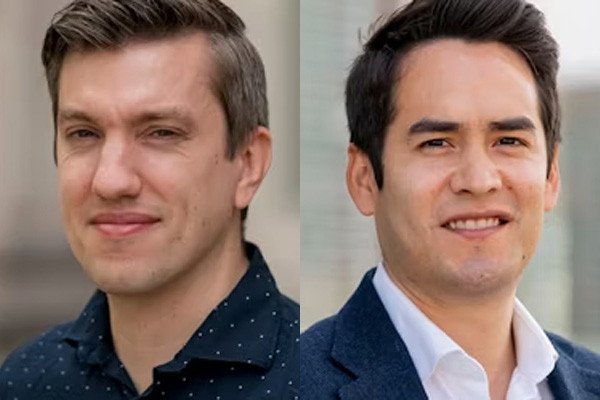Lawrence, Seáñez win Collaboration Initiation Grants
The one-year awards promote collaborative research within the university

Mark Lawrence and Ismael Seáñez, both assistant professors in the McKelvey School of Engineering, have been awarded $25,000 Collaboration Initiation Grants from the school.
The program awards one-year grants to projects that facilitate collaborative research within McKelvey Engineering departments and other university departments for tenure-track faculty. The grants are a pathway for faculty to apply for larger interdisciplinary grants, to create a more synergistic project than could be achieved by one researcher in one discipline, and to demonstrate the potential to sustain the collaboration and obtain external funding. Each awardee receives $20,000 from the school and must have $5,000 in cost-sharing from their department or collaborators.
Lawrence, assistant professor in the Preston M. Green Department of Electrical & Systems Engineering, is collaborating with Erik Henriksen, associate professor of physics, on a project looking to take advantage of the unique charge transport properties of graphene to turn single infrared photon absorption events into strong microwave signals, measurable even when there is significant thermal noise. To overcome the very low probability of a photon being absorbed in an atomically thin flake, Lawrence and Henriksen will design and create nanophotonic cavities to funnel light into the graphene. They expect that these developments will unlock single photon detectors in the infrared with detection efficiencies approaching 100% without the need for refrigeration.
Seáñez, assistant professor of biomedical engineering, is collaborating with Camilo Molina, MD, assistant professor of neurosurgery and of orthopedic surgery, and Lara W. Crock, MD, PhD, assistant professor of anesthesiology, both at the School of Medicine, on a project co-funded by the Institute of Clinical and Translational Sciences (ICTS) at the School of Medicine. The team’s long-term goal is to speed the development of applications to restore lost functions in those with neurological disease and injury. They plan to obtain direct spinal recordings in individuals receiving spinal implants as part of their standard care during passive and voluntary single joint movements. They expect that determining the frequencies and amplitudes of neural activity associated with different muscle activations will provide information about which frequencies and amplitudes they may want to use topographically in the spinal cord to recruit a specific group of muscle, which will improve stimulation therapies for those with spinal cord injuries.
Research reported in this publication was supported by the Washington University Institute of Clinical and Translational Sciences grant UL1TR002345 from the National Center for Advancing Translational Sciences (NCATS) of the National Institutes of Health (NIH). The content is solely the responsibility of the authors and does not necessarily represent the official view of the NIH.





